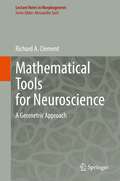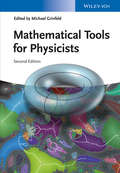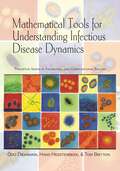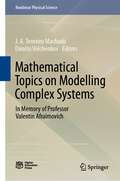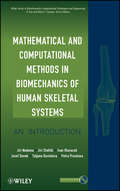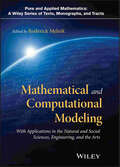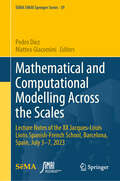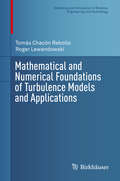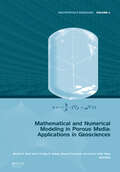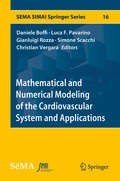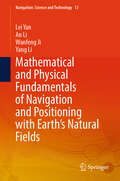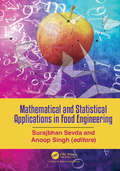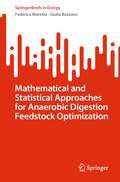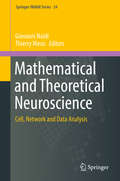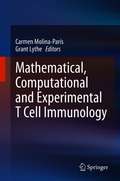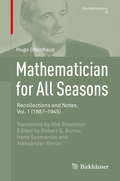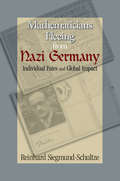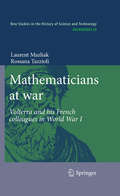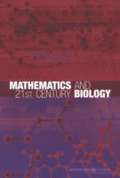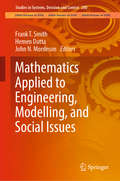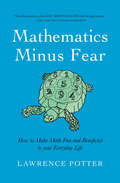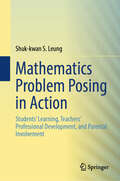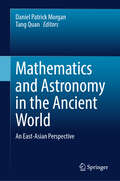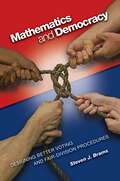- Table View
- List View
Mathematical Tools for Neuroscience: A Geometric Approach (Lecture Notes in Morphogenesis)
by Richard A. ClementThis book provides a brief but accessible introduction to a set of related, mathematical ideas that have proved useful in understanding the brain and behaviour. If you record the eye movements of a group of people watching a riverside scene then some will look at the river, some will look at the barge by the side of the river, some will look at the people on the bridge, and so on, but if a duck takes off then everybody will look at it. How come the brain is so adept at processing such biological objects? In this book it is shown that brains are especially suited to exploiting the geometric properties of such objects. Central to the geometric approach is the concept of a manifold, which extends the idea of a surface to many dimensions. The manifold can be specified by collections of n-dimensional data points or by the paths of a system through state space. Just as tangent planes can be used to analyse the local linear behaviour of points on a surface, so the extension to tangent spaces can be used to investigate the local linear behaviour of manifolds. The majority of the geometric techniques introduced are all about how to do things with tangent spaces.Examples of the geometric approach to neuroscience include the analysis of colour and spatial vision measurements and the control of eye and arm movements. Additional examples are used to extend the applications of the approach and to show that it leads to new techniques for investigating neural systems. An advantage of following a geometric approach is that it is often possible to illustrate the concepts visually and all the descriptions of the examples are complemented by comprehensively captioned diagrams.The book is intended for a reader with an interest in neuroscience who may have been introduced to calculus in the past but is not aware of the many insights obtained by a geometric approach to the brain. Appendices contain brief reviews of the required background knowledge in neuroscience and calculus.
Mathematical Tools for Physicists
by Michael GrinfeldThe new edition is significantly updated and expanded.This unique collection of review articles, ranging from fundamental concepts up to latest applications, contains individual contributions written by renowned experts in the relevant fields. Much attention is paid to ensuring fast access to the information, with each carefully reviewed article featuring cross-referencing, references to the most relevant publications in the field, and suggestions for further reading, both introductory as well as more specialized.While the chapters on group theory, integral transforms, Monte Carlo methods, numerical analysis, perturbation theory, and special functions are thoroughly rewritten, completely new content includes sections on commutative algebra, computational algebraic topology, differential geometry, dynamical systems, functional analysis, graph and network theory, PDEs of mathematical physics, probability theory, stochastic differential equations, and variational methods.
Mathematical Tools for Understanding Infectious Disease Dynamics (Princeton Series in Theoretical and Computational Biology #7)
by Hans Heesterbeek Odo Diekmann Tom BrittonMathematical modeling is critical to our understanding of how infectious diseases spread at the individual and population levels. This book gives readers the necessary skills to correctly formulate and analyze mathematical models in infectious disease epidemiology, and is the first treatment of the subject to integrate deterministic and stochastic models and methods.Mathematical Tools for Understanding Infectious Disease Dynamics fully explains how to translate biological assumptions into mathematics to construct useful and consistent models, and how to use the biological interpretation and mathematical reasoning to analyze these models. It shows how to relate models to data through statistical inference, and how to gain important insights into infectious disease dynamics by translating mathematical results back to biology. This comprehensive and accessible book also features numerous detailed exercises throughout; full elaborations to all exercises are provided.Covers the latest research in mathematical modeling of infectious disease epidemiologyIntegrates deterministic and stochastic approachesTeaches skills in model construction, analysis, inference, and interpretationFeatures numerous exercises and their detailed elaborationsMotivated by real-world applications throughout
Mathematical Topics on Modelling Complex Systems: In Memory of Professor Valentin Afraimovich (Nonlinear Physical Science)
by Dimitri Volchenkov J. A. Tenreiro MachadoThis book explores recent developments in theoretical research and mathematical modelling of real-world complex systems, organized in four parts. The first part of the book is devoted to the mathematical tools for the design and analysis in engineering and social science study cases. We discuss the periodic evolutions in nonlinear chemical processes, vibro-compact systems and their behaviour, different types of metal–semiconductor self-assembled samples, made of silver nanowires and zinc oxide nanorods. The second part of the book is devoted to mathematical description and modelling of the critical events, climate change and robust emergency scales. In three chapters, we consider a climate-economy model with endogenous carbon intensity and the behaviour of Tehran Stock Exchange market under international sanctions. The third part of the book is devoted to fractional dynamic and fractional control problems. We discuss the novel operational matrix technique for variable-order fractional optimal control problems, the nonlinear variable-order time fractional convection–diffusion equation with generalized polynomials The fourth part of the book concerns solvability and inverse problems in differential and integro-differential equations. The book facilitates a better understanding of the mechanisms and phenomena in nonlinear dynamics and develops the corresponding mathematical theory to apply nonlinear design to practical engineering. It can be read by mathematicians, physicists, complex systems scientists, IT specialists, civil engineers, data scientists and urban planners.
Mathematical and Computational Methods and Algorithms in Biomechanics
by Jiri Stehlik Jirí NedomaCutting-edge solutions to current problems in orthopedics, supported by modeling and numerical analysisDespite the current successful methods and achievements of good joint implantations, it is essential to further optimize the shape of implants so they may better resist extreme long-term mechanical demands. This book provides the orthopedic, biomechanical, and mathematical basis for the simulation of surgical techniques in orthopedics. It focuses on the numerical modeling of total human joint replacements and simulation of their functions, along with the rigorous biomechanics of human joints and other skeletal parts. The book includes: An introduction to the anatomy and biomechanics of the human skeleton, biomaterials, and problems of alloarthroplasty The definition of selected simulated orthopedic problems Constructions of mathematical model problems of the biomechanics of the human skeleton and its parts Replacement parts of the human skeleton and corresponding mathematical model problems Detailed mathematical analyses of mathematical models based on functional analysis and finite element methods Biomechanical analyses of particular parts of the human skeleton, joints, and corresponding replacements A discussion of the problems of data processing from nuclear magnetic resonance imaging and computer tomographyThis timely book offers a wealth of information on the current research in this field. The theories presented are applied to specific problems of orthopedics. Numerical results are presented and discussed from both biomechanical and orthopedic points of view and treatment methods are also briefly addressed. Emphasis is placed on the variational approach to the investigated model problems while preserving the orthopedic nature of the investigated problems. The book also presents a study of algorithmic procedures based on these simulation models.This is a highly useful tool for designers, researchers, and manufacturers of joint implants who require the results of suggested experiments to improve existing shapes or to design new shapes. It also benefits graduate students in orthopedics, biomechanics, and applied mathematics.</p
Mathematical and Computational Modeling
by Roderick MelnikIllustrates the application of mathematical and computational modeling in a variety of disciplines With an emphasis on the interdisciplinary nature of mathematical and computational modeling, Mathematical and Computational Modeling: With Applications in the Natural and Social Sciences, Engineering, and the Arts features chapters written by well-known, international experts in these fields and presents readers with a host of state-of-the-art achievements in the development of mathematical modeling and computational experiment methodology. The book is a valuable guide to the methods, ideas, and tools of applied and computational mathematics as they apply to other disciplines such as the natural and social sciences, engineering, and technology. Mathematical and Computational Modeling: With Applications in the Natural and Social Sciences, Engineering, and the Arts also features: Rigorous mathematical procedures and applications as the driving force behind mathematical innovation and discovery Numerous examples from a wide range of disciplines to emphasize the multidisciplinary application and universality of applied mathematics and mathematical modeling Original results on both fundamental theoretical and applied developments in diverse areas of human knowledge Discussions that promote interdisciplinary interactions between mathematicians, scientists, and engineers Mathematical and Computational Modeling: With Applications in the Natural and Social Sciences, Engineering, and the Arts is an ideal resource for professionals in various areas of mathematical and statistical sciences, modeling and simulation, physics, computer science, engineering, biology and chemistry, industrial, and computational engineering. The book also serves as an excellent textbook for graduate courses in mathematical modeling, applied mathematics, numerical methods, operations research, and optimization.
Mathematical and Computational Modelling Across the Scales: Lecture Notes of the XX Jacques-Louis Lions Spanish-French School, Barcelona, Spain, July 3-7, 2023 (SEMA SIMAI Springer Series #39)
by Pedro Diez Matteo GiacominiMany physical and engineering systems deal with micro-, meso-, macro-, and multi-scale phenomena. The accurate description and the reliable simulation of such phenomena entail major challenges from the point of view of both mathematical modelling and computational engineering. This book covers a selection of challenges related to "Mathematical and Computational Modelling Across the Scales”, stemming from the lecture notes of the XX edition of the Jacques-Louis Lions Spanish-French School in Numerical Simulations in Physics & Engineering. The thematic focus is broad, encompassing mathematical models of complex physical problems, theoretical results on their derivation, and development of numerical methods for their efficient simulation. The contributions of the book include: uncertainty quantification for phenomena at different scales such as epidemic dynamics, medical imaging, and geophysical exploration; structural health monitoring integrating small-scale sensor data in large-scale computational models; frontier numerical methods for the simulation of geophysical and heliophysical dynamics accounting for multi-scale, heterogeneous media; multi-physics, multi-scale models for the mechanobiology of atheroma plaques formation; locomotion models for swimming at the micro-scale; mathematical foundations of quantum mechanics phenomena at the micro-scale. The book is addressed to scientists and engineers, from both academia and industry, interested in the mathematical modelling and numerical simulation of a variety of complex systems in physics and engineering characterised by multiple scales.
Mathematical and Numerical Foundations of Turbulence Models and Applications
by Tomás Chacón Rebollo Roger LewandowskiWith applications to climate, technology, and industry, the modeling and numerical simulation of turbulent flows are rich with history and modern relevance. The complexity of the problems that arise in the study of turbulence requires tools from various scientific disciplines, including mathematics, physics, engineering and computer science. Authored by two experts in the area with a long history of collaboration, this monograph provides a current, detailed look at several turbulence models from both the theoretical and numerical perspectives. The k-epsilon, large-eddy simulation and other models are rigorously derived and their performance is analyzed using benchmark simulations for real-world turbulent flows. Mathematical and Numerical Foundations of Turbulence Models and Applications is an ideal reference for students in applied mathematics and engineering, as well as researchers in mathematical and numerical fluid dynamics. It is also a valuable resource for advanced graduate students in fluid dynamics, engineers, physical oceanographers, meteorologists and climatologists.
Mathematical and Numerical Modeling in Porous Media: Applications in Geosciences (Multiphysics Modeling)
by Martín A. Díaz Viera Pratap N. Sahay Theo M. Nieuwenhuizen Manuel Coronado Arturo Ortiz TapiaPorous media are broadly found in nature and their study is of high relevance in our present lives. In geosciences porous media research is fundamental in applications to aquifers, mineral mines, contaminant transport, soil remediation, waste storage, oil recovery and geothermal energy deposits. Despite their importance, there is as yet no complete
Mathematical and Numerical Modeling of the Cardiovascular System and Applications (SEMA SIMAI Springer Series #16)
by Gianluigi Rozza Daniele Boffi Simone Scacchi Luca F. Pavarino Christian VergaraThe book comprises contributions by some of the most respected scientists in the field of mathematical modeling and numerical simulation of the human cardiocirculatory system. It covers a wide range of topics, from the assimilation of clinical data to the development of mathematical and computational models, including with parameters, as well as their efficient numerical solution, and both in-vivo and in-vitro validation. It also considers applications of relevant clinical interest. This book is intended for graduate students and researchers in the field of bioengineering, applied mathematics, computer, computational and data science, and medicine wishing to become involved in the highly fascinating task of modeling the cardiovascular system.
Mathematical and Physical Fundamentals of Navigation and Positioning with Earth's Natural Fields (Navigation: Science and Technology #13)
by An Li Yang Li Lei Yan Wanfeng JiThis book covers various fields relevant to navigation, including Earth's magnetic field, gravity field, topography, celestial polarization field, electrostatic field, and relativistic celestial field effects. It introduces the principles and applications of navigation positioning using various natural field navigation and terrain-assisted methods, including gravity field navigation positioning, geomagnetic field navigation positioning, terrain-assisted navigation positioning, polarization field navigation positioning, electrostatic field navigation positioning, and relativistic effect verification. This book comprehensively introduces the algorithm principles and engineering implementation approaches, providing basic theoretical support for precision navigation positioning and deep space exploration. Based on the principles of gravity, geomagnetic, and terrain-assisted navigation positioning, corresponding to the universal gravitational force and Earth's rotation in Newtonian mechanics, it combines polarization field navigation positioning with the energy field effect of solar incident light waves, as well as electrostatic field navigation positioning with relativistic effect verification. This forms a relatively complete theoretical technical system and abstracts the mathematical essence of each link in the geomagnetic, gravity, and terrain navigation positioning systems. Taking mechanism exploration and algorithm implementation as the basic approach, it has confirmed the theoretical correctness and practical feasibility of natural field navigation positioning through verification with actual measurement data. This book is mainly targeted at professionals, researchers, students, and readers interested in deep space, deep Earth, deep sea, and polar exploration, as well as those working in the field of navigation positioning. It is of reference value in deep space, deep Earth, and deep sea exploration.
Mathematical and Statistical Applications in Food Engineering
by Anoop Singh Surajbhan SevdaWritten by experts from all over the world, the book comprises the latest applications of mathematical and models in food engineering and fermentation. It provides the fundamentals on statistical methods to solve standard problems associated with food engineering and fermentation technology. Combining theory with a practical, hands-on approach, this book covers key aspects of food engineering. Presenting cuttingedge information, the book is an essential reference on the fundamental concepts associated with food engineering.
Mathematical and Statistical Applications in Life Sciences and Engineering
by Mahima Ranjan Adhikari Avishek Adhikari Yogendra Prasad ChaubeyThe book includes articles from eminent international scientists discussing a wide spectrum of topics of current importance in mathematics and statistics and their applications. It presents state-of-the-art material along with a clear and detailed review of the relevant topics and issues concerned. The topics discussed include message transmission, colouring problem, control of stochastic structures and information dynamics, image denoising, life testing and reliability, survival and frailty models, analysis of drought periods, prediction of genomic profiles, competing risks, environmental applications and chronic disease control. It is a valuable resource for researchers and practitioners in the relevant areas of mathematics and statistics.
Mathematical and Statistical Approaches for Anaerobic Digestion Feedstock Optimization (SpringerBriefs in Energy)
by Federico Moretta Giulia BozzanoThis book examines biomass mixture modeling and optimization. The book discusses anaerobic digestion and related fermentative processes and explains their compositional dynamics. Early chapter examine macromolecules, elemental fractions, and their direct influence on methane production. Supported by an extensive data bank of substrates obtained from research, the book points out correlations that enable the estimation of global methane production for diverse biomass mixtures. Furthermore, it provides valuable insights into discerning the optimal composition capable of yielding the utmost methane output.The book integrates cutting-edge machine learning techniques and shows how the programming language Python and Julia can be used for analysis and to optimize processes. It has many graphs, figures, and visuals.
Mathematical and Theoretical Neuroscience: Cell, Network And Data Analysis (Springer INdAM #24)
by Giovanni Naldi Thierry NieusThis volume gathers contributions from theoretical, experimental and computational researchers who are working on various topics in theoretical/computational/mathematical neuroscience. The focus is on mathematical modeling, analytical and numerical topics, and statistical analysis in neuroscience with applications. The following subjects are considered: mathematical modelling in Neuroscience, analytical and numerical topics; statistical analysis in Neuroscience; Neural Networks; Theoretical Neuroscience. The book is addressed to researchers involved in mathematical models applied to neuroscience.
Mathematical, Computational and Experimental T Cell Immunology
by Carmen Molina-París Grant LytheMathematical, statistical, and computational methods enable multi-disciplinary approaches that catalyse discovery. Together with experimental methods, they identify key hypotheses, define measurable observables and reconcile disparate results. This volume collects a representative sample of studies in T cell immunology that illustrate the benefits of modelling-experimental collaborations and which have proven valuable or even ground-breaking. Studies include thymic selection, T cell repertoire diversity, T cell homeostasis in health and disease, T cell-mediated immune responses, T cell memory, T cell signalling and analysis of flow cytometry data sets. Contributing authors are leading scientists in the area of experimental, computational, and mathematical immunology. Each chapter includes state-of-the-art and pedagogical content, making this book accessible to readers with limited experience in T cell immunology and/or mathematical and computational modelling.
Mathematician for All Seasons
by Hugo SteinhausRobert G. Burns Irena Szymaniec Aleksander WeronThis book presents, in his own words, the life of Hugo Steinhaus (1887-1972), noted Polish mathematician of Jewish background, educator, and mathematical popularizer. A student of Hilbert, a pioneer of the foundations of probability and game theory, and a contributor to the development of functional analysis, he was one of those instrumental to the extraordinary flowering of Polish mathematics before and after World War I. In particular, it was he who "discovered" the great Stefan Banach. Exhibiting his great integrity and wit, Steinhaus's personal story of the turbulent times he survived - including two world wars and life postwar under the Soviet heel - cannot but be of consuming interest. His recounting of the fearful years spent evading Nazi terror is especially moving. The steadfast honesty and natural dignity he maintained while pursuing a life of demanding scientific and intellectual enquiry in the face of encroaching calamity and chaos show him to be truly a mathematician for all seasons. The present work will be of great interest not only to mathematicians wanting to learn some of the details of the mathematical blossoming that occurred in Poland in the first half of the 20th century, but also to anyone wishing to read a first-hand account of the history of those unquiet times in Europe - and indeed world-wide - by someone of uncommon intelligence and forthrightness situated near an eye of the storm.
Mathematicians Fleeing from Nazi Germany: Individual Fates and Global Impact
by Reinhard Siegmund-SchultzeThe emigration of mathematicians from Europe during the Nazi era signaled an irrevocable and important historical shift for the international mathematics world. Mathematicians Fleeing from Nazi Germany is the first thoroughly documented account of this exodus. In this greatly expanded translation of the 1998 German edition, Reinhard Siegmund-Schultze describes the flight of more than 140 mathematicians, their reasons for leaving, the political and economic issues involved, the reception of these emigrants by various countries, and the emigrants' continuing contributions to mathematics. The influx of these brilliant thinkers to other nations profoundly reconfigured the mathematics world and vaulted the United States into a new leadership role in mathematics research. Based on archival sources that have never been examined before, the book discusses the preeminent emigrant mathematicians of the period, including Emmy Noether, John von Neumann, Hermann Weyl, and many others. The author explores the mechanisms of the expulsion of mathematicians from Germany, the emigrants' acculturation to their new host countries, and the fates of those mathematicians forced to stay behind. The book reveals the alienation and solidarity of the emigrants, and investigates the global development of mathematics as a consequence of their radical migration. An in-depth yet accessible look at mathematics both as a scientific enterprise and human endeavor, Mathematicians Fleeing from Nazi Germany provides a vivid picture of a critical chapter in the history of international science.
Mathematicians at war
by Laurent Mazliak Rossana TazzioliNumerous scientists have taken part in the war effort during World War I, but few gave it the passionate energy of the prominent Italian mathematician Volterra. As a convinced supporter of the cause of Britain and France, he struggled vigorously to carry Italy into the war in May 1915 and then developed a frenetic activity to support the war effort, going himself to the front, even though he was 55. This activity found an adequate echo with his French colleagues Borel, Hadamard and Picard. The huge correspondence they exchanged during the war, gives an extraordinary view of these activities, and raises numerous fundamental questions about the role of a scientist, and particularly a mathematician during WW I. It also offers a vivid documentation about the intellectual life of the time ; Volterra's and Borel's circles in particular were extremely wide and the range of their interests was not limited to their field of specialization. The book proposes the complete transcription of the aforementioned correspondence, annotated with numerous footnotes to give details on the contents. It also offers a general historical introduction to the context of the letters and several complements on themes related to the academic exchanges between France and Italy during the war.
Mathematics And 21st Century Biology
by National Research Council of the National AcademiesThe exponentially increasing amounts of biological data along with comparable advances in computing power are making possible the construction of quantitative, predictive biological systems models. This development could revolutionize those biology-based fields of science. To assist this transformation, the U.S. Department of Energy asked the National Research Council to recommend mathematical research activities to enable more effective use of the large amounts of existing genomic information and the structural and functional genomic information being created. The resulting study is a broad, scientifically based view of the opportunities lying at the mathematical science and biology interface. The book provides a review of past successes, an examination of opportunities at the various levels of biological systems— from molecules to ecosystems—an analysis of cross-cutting themes, and a set of recommendations to advance the mathematics-biology connection that are applicable to all agencies funding research in this area.
Mathematics Applied to Engineering, Modelling, and Social Issues (Studies in Systems, Decision and Control #200)
by John N. Mordeson Hemen Dutta Frank T. SmithThis book presents several aspects of research on mathematics that have significant applications in engineering, modelling and social matters, discussing a number of current and future social issues and problems in which mathematical tools can be beneficial. Each chapter enhances our understanding of the research problems in a particular an area of study and highlights the latest advances made in that area. The self-contained contributions make the results and problems discussed accessible to readers, and provides references to enable those interested to follow subsequent studies in still developing fields. Presenting real-world applications, the book is a valuable resource for graduate students, researchers and educators. It appeals to general readers curious about the practical applications of mathematics in diverse scientific areas and social problems.
Mathematics Minus Fear: How to Make Math Fun and Beneficial to Your Everyday Life
by Lawrence PotterForget your classroom nightmares and discover how numbers can enhance and illuminate your world!How can math help you bet on horses or win in Vegas? What's the foolproof way to solve Sudoku? How can probability teach you to calculate your chances of survival in Russian roulette?In this irreverent and entertaining guide to mathematics, Lawrence Potter takes the fear out of everything from long division to percentages. Using fascinating puzzles and surprising examples, he shows us how math is connected with the world we encounter every day, from how the VAT works to why weather forecasts are wrong, from winning at Monopoly to improving your mental arithmetic. Along the way you'll also discover who invented numbers, whether animals can count, and what nuns have to do with multiplication.
Mathematics Problem Posing in Action: Students’ Learning, Teachers’ Professional Development, and Parental Involvement
by Shuk-kwan S. LeungThis book provides actual examples of challenging implementations of Math Problem Posing in school, teaching education settings, and home environments. Firstly, it explains how a teacher educator introduced Math Problem Posing to students using concrete tasks and assessment methods. Secondly, it discusses how a teacher educator worked with school teachers to use tasks, assessed students and to develop more tasks. Thirdly, it describes cases on how a teacher educator and parents used Math Problem Posing at home and in out of school settings. This is a book dedicated to researchers, teachers, students, and parents and also all those who are interested in the use of posing problems for active learning and teaching.
Mathematics and Astronomy in the Ancient World: An East-Asian Perspective
by Daniel Patrick Morgan Tang QuanThis book contains an edited selection of the papers presented at the Second International Conference on the History of Ancient Mathematics and Astronomy (ICHAMA), organized by Tang Quan and Qu Anjing and held in Xi’an, 2–8 December 2018, commemorating the foundation. This collection, consisting of papers that have been refined and edited into scientific articles, provides an overview of how the history of science can be international, stepping beyond area studies, without being Euro-centric. Containing chapters written by East Asia scholars who do not publish widely in English, the volume opens an important window into their projects and the state of scholarship in their respective countries in relation to the history of mathematics and astronomy. As the contributions span a spectrum of senior and junior scholars, they are of great interest to an academic audience of researchers and post-graduate students in the history of science and the history of mathematics and astronomy in particular.
Mathematics and Democracy: Designing Better Voting and Fair-Division Procedures
by Steven J. BramsVoters today often desert a preferred candidate for a more viable second choice to avoid wasting their vote. Likewise, parties to a dispute often find themselves unable to agree on a fair division of contested goods. In Mathematics and Democracy, Steven Brams, a leading authority in the use of mathematics to design decision-making processes, shows how social-choice and game theory could make political and social institutions more democratic. Using mathematical analysis, he develops rigorous new procedures that enable voters to better express themselves and that allow disputants to divide goods more fairly. One of the procedures that Brams proposes is "approval voting," which allows voters to vote for as many candidates as they like or consider acceptable. There is no ranking, and the candidate with the most votes wins. The voter no longer has to consider whether a vote for a preferred but less popular candidate might be wasted. In the same vein, Brams puts forward new, more equitable procedures for resolving disputes over divisible and indivisible goods.
